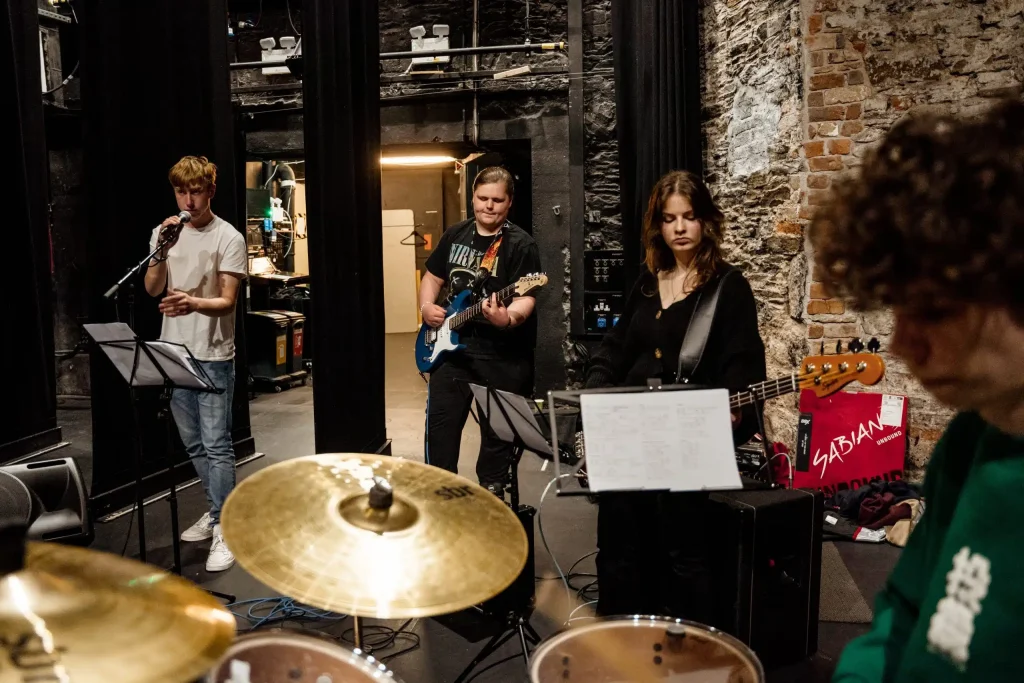How To Jam With Other Musicians: Jamming with other musicians is a fantastic way to create music and have fun.
Table of Contents
Hi. Ian here and welcome to this article!

Ever crank up the tunes at home, air guitar wailing, and dream of creating music with others?
You’re not alone! Jamming with fellow musicians is a fantastic way to unleash creativity, have a blast, and seriously up your musical game.
But that first jam session can feel intimidating, right?
Fear not, my friend! Buckle up as we explore the exhilarating world of jamming with other musicians – from finding your crew to rocking out like a pro.
First things first, how do you find your musical soulmates? Well, the music scene might be closer than you think! Local music stores often have bulletin boards where musicians connect. Band websites sometimes advertise for jam partners, and let’s not forget the power of social media! There are countless online groups dedicated to jamming, so get out there and start searching.
Now, you’ve got your crew – awesome! But before you dive into a face-melting guitar solo, remember jamming is a conversation. Listen intently to your fellow musicians. What kind of groove are they laying down? Are they feeling funky or melancholic? Adapt your playing to complement theirs, creating a musical tapestry together. It’s all about building on each other’s ideas and creating something beautiful in the moment.
So, are you ready to unleash your inner rockstar? In the next part of this guide, we’ll delve into the essential skills for a killer jam session, from understanding basic music theory to mastering the art of listening. Stay tuned, and we’ll have you jamming like a pro in no time!
Getting Started with Jamming

Jamming with other musicians can be a thrilling and productive experience, whether you’re a beginner or a seasoned player. Here’s how to kick things off.
Finding the Right Musicians
To get started, seek out friends or individuals in your community with similar musical interests. Music forums, local Facebook groups, and notice boards at music shops are excellent places to find potential jam partners. If you’re a guitarist, look for drummers, bassists, and keyboard players – a versatile mix of instruments can enrich your jam session.
Choosing a Place to Jam
Decide on a location that’s accessible and comfortable for everyone. It could be a home studio, a rented rehearsal space, or a quiet spot in a community centre. Ensure the place is conducive to practice and that neighbours won’t be disturbed.
Setting Up the Session
When everyone’s gathered, discuss the genres you all enjoy and set up a playlist of songs to cover. Start with simple tunes that allow each instrument to shine and gradually work your way up to more complex pieces as your group gets comfortable. Make sure everyone knows their role, whether they’re on the guitar, drums, or bass, to maintain harmony during the session. Setting up a regular schedule for your jam sessions can help maintain momentum and improve everyone’s skills.
Equipment Essentials
Before you gather with fellow musicians for a jam session, ensure you’ve got your equipment essentials sorted. It’s not just about having an instrument—the right gear can make all the difference to your sound and the overall experience.
Instrument Selection
Your choice of instrument for the jam session is foundational. If you’re a guitarist, consider whether the session calls for an electric or acoustic guitar. Bass players should bring a dependable four-string that they’re comfortable with.
Amplification and Sound
Getting your sound just right is critical. For electric instruments, a reliable amplifier is a must. An amp that offers a good balance between volume and tone without overshadowing others is ideal. For acoustic instruments, a DI box may be necessary to plug into the PA system. Always carry extra cables to avoid any last-minute hiccups.
Necessary Accessories
Remember to pack all your accessories:
- Tuner: Keep your instrument in tune with a good-quality tuner.
- Picks: Guitar and bass players should have a few extra picks.
- Headphones: Useful for hearing your mix or in case of a computer-based setup.
- If you’re incorporating electronic elements, bring your computer or Mac along with any required software.
Playing Together
When you’re jamming with other musicians, the magic of the moment comes from your group’s ability to communicate effectively, maintain a solid rhythmic base, and control the dynamics to create an enjoyable musical experience.
Communication and Signals
It’s essential to establish a non-verbal language that includes eye contact and gestures. These cues help you navigate through the session without interrupting the groove. For example, a nod might mean the start of a solo, while a hand raise could signal the end of a piece.
Maintaining Rhythm and Harmony
Rhythm and harmony are the backbone of your jam session. Pay attention to your bandmates to keep in sync and create a unified sound. Teamwork here is crucial — if someone loses the beat, jump in subtly to guide them back without breaking the flow of the music.
Dynamics and Volume Control
Managing the dynamics and volume of your playing ensures that no instrument overpowers another. Strive for a balance where you can hear each part clearly, working toward a collective sound rather than individual performances. Remember, your teamwork in controlling volume contributes significantly to the success of your group’s sound.
By focusing on these elements, you’ll be able to play together as a cohesive unit, and your jamming sessions will be all the more rewarding.
Improvisation and Creativity
When you jam with other musicians, improvisation, and creativity are the heartbeats of your session. They allow for spontaneous musical conversations and moments of unique brilliance.
Playing by Ear and Adapting
Being able to play by ear is a tremendous asset in a jam session. It means quickly identifying the notes and chords by listening and seamlessly joining in the flow of music. You have to trust your ear, discard the fear of making mistakes, and embrace the chance to add your personal flair.
When it’s your turn to lead with a solo, you’ll find that fearlessness and a comfortable grip on your instrument can lead to those magical moments you often admire in seasoned musicians. Always remember, though, while spontaneity is key, it’s respectful to the group to maintain the groove and enhance what’s already happening, rather than overshadowing it.
In your improvisation journey, creativity blossoms when you step out of your comfort zone. Experiment with new note combinations and rhythmic patterns or even vary the dynamics of your solos to see what fits best within the jam. It’s not only about playing it safe—your fellow jamming partners will appreciate the freshness you bring to the table.
Expanding Your Jam Experience
Before you can master the art of the jam, you’ve got to step out of your comfort zone and into the mix. It’s in the vibrant setting of a jam session where you’ll not only have fun but also learn and grow as a musician.
Joining Open Mic Nights and Jams
Embark on a musical journey by participating in open mic nights and jams. These events provide a platform for musicians of all skill levels and musical styles—from jazz and blues to rap—to share their talent and collaborate. Here’s how you can take advantage of these opportunities:
- Research Local Venues: Keep an eye out for cafes, bars, and community centres hosting open mic nights. These are brilliant places to meet fellow musicians.
- Mix Genres and Styles: Don’t shy away from swinging to some jazz or grooving to blues. Trying different genres can enhance your versatility.
- Prepare a Few Pieces: Whether it’s original music or a classic cover, having a few songs ready to play makes you a valuable jamming partner.
- Observe & Learn: Watching others perform offers insights into new techniques and styles that can bolster your playing.
- Network: These events are about more than the music; they’re a chance to connect with others who share your passion and can potentially offer guidance.
- Receive & Give Feedback: Constructive criticism is a tremendous learning opportunity. Be open to feedback and respectfully offer your own to help others grow.
Remember, the goal is to have fun and improve. Every jam session is a unique experience that can significantly contribute to your development as a musician. Leap in and join the next open mic night—your musical journey awaits!
Frequently Asked Questions
If you’re new to jamming with other musicians or are looking to dive into specific genres like jazz, you might have questions. Here’s some guidance aimed to help you navigate the exciting world of musical collaboration.
Could you offer tips for beginners wanting to jam with other players?
When you’re first starting out, the idea of jamming with other musicians can be daunting. Remember teamwork is essential; support each other in the process. You might find it beneficial to control your volume and dynamics, especially if you’re playing rhythm guitar, to blend well with the group.
What’s involved in a jam session within the jazz genre?
Jazz jam sessions require a good understanding of improvisation and a deep knowledge of jazz standards. It’s all about listening and responding to what the other musicians are playing, creating a conversation through your instruments. Mastering the art of jazz requires attentiveness and the flexibility to adapt to spontaneous changes in rhythm and key.
How can musicians collaborate and jam remotely over the internet?
Technology today allows musicians to collaborate and jam remotely using various online platforms. For a smooth experience, each musician needs a reliable internet connection, quality microphones, and headphones. Software that minimises latency can aid real-time collaboration.
Where can one find local opportunities or venues to jam with other musicians?
Finding a place to jam might seem tricky, but local music venues, community centres, and music schools often host jam sessions. Online community boards and social media groups are also valuable resources for connecting with fellow musicians. Don’t hesitate to reach out and introduce yourself to these communities – they’re always looking for new talent to join the mix.
Conclusion
Jamming with other musicians is a rewarding way to share your passion for music and improve your skills. Embrace the opportunity to play rhythm guitar most of the time, understanding that this underpins the group’s harmony and allows you to contribute to the collective sound effectively. Remember the importance of good listening skills and the ability to adapt quickly to what others are playing.
Here are a few key takeaways to ensure your next jam session is a success:
- Prepare: Practise some versatile chord progressions and riffs beforehand.
- Listen: Pay attention to your fellow musicians and adjust your playing as necessary.
- Communicate: Agree on keys, tempo, and structure to keep everyone in sync.
- Share the Spotlight: Give everyone a chance to solo and express themselves.
- Enjoy: Have fun and savour the experience of creating music together.
For more detailed guidance, you might want to check out these 9 tips on how to jam on guitar or explore the art of improvisation to enrich your jamming experience.
By respecting one another’s contributions and focusing on the joy of collective music-making, you’ll not only create great music but also build lasting musical relationships. Keep an open mind, be adaptable, and most importantly, enjoy every moment.
